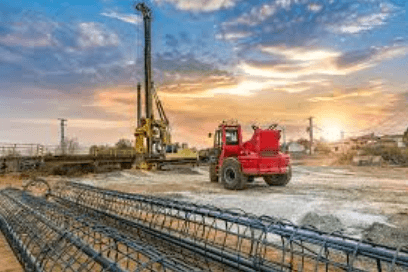Piling Contractors: The Foundation of Modern Construction

Piling contractors are the unsung heroes of the construction industry, responsible for laying the deep foundations that support buildings, bridges, and other significant structures.
Their expertise ensures stability, safety, and longevity in construction projects, often working in challenging environments to achieve optimal results.
This article explores the critical role of piling contractors, the types of piling methods, materials used, construction techniques, and their importance in modern construction.
The Role of Piling Contractors
Piling contractors specialize in designing and installing deep foundations, known as piles, which transfer the load of a structure to the soil or rock layers deep below the surface. Their primary objectives include:
1. Load Bearing and Stability
Piling contractors ensure that the weight of a structure is effectively distributed to prevent settlement and structural failure. This is especially crucial in areas with weak or variable soil conditions.
2. Supporting Structures in Challenging Environments
In environments where surface soils are not strong enough to support structures, such as near water bodies or on reclaimed land, piling contractors provide the necessary support through deep foundations.
3. Ensuring Longevity and Durability
Properly installed piles contribute to the longevity and durability of structures by minimizing the risk of foundation movement, cracking, or collapse over time.
4. Addressing Geotechnical Challenges
Piling contractors analyze soil conditions and other geotechnical factors to determine the most suitable piling method for each project, ensuring optimal performance and safety.
Types of Piling Methods
Piling contractors employ various piling methods, each suited to specific soil conditions, load requirements, and project constraints. The primary methods include:
1. Driven Piles
Driven piles are prefabricated piles that are hammered into the ground using hydraulic or diesel hammers. These piles can be made from materials such as steel, concrete, or timber. Driven piles are suitable for various soil types and are often used in large-scale projects like bridges and high-rise buildings.
2. Bored Piles
Bored piles, also known as drilled shafts, are created by drilling a hole into the ground and filling it with concrete. Reinforcement, such as steel cages, is often added to increase the pile’s strength. Bored piles are ideal for projects requiring large-diameter piles and in areas with limited access for driving equipment.
3. Screw Piles
Screw piles, or helical piles, have a helical blade attached to a central shaft. These piles are screwed into the ground using hydraulic torque, creating minimal soil displacement. Screw piles are commonly used in residential construction, solar farms, and other projects where minimal vibration and disturbance are essential.
4. Sheet Piles
Sheet piles are thin, interlocking sheets driven into the ground to form a continuous barrier. These piles are typically used for retaining walls, cofferdams, and seawalls. Materials for sheet piles include steel, vinyl, and composite materials.
5. Mini Piles
Mini piles, or micro piles, are small-diameter piles that can be installed using lightweight equipment. They are suitable for projects with restricted access or where minimal disturbance is required, such as in urban areas or near existing structures.
6. CFA Piles
Continuous Flight Auger (CFA) piles are constructed by drilling into the ground with a continuous flight auger, then filling the hole with concrete as the auger is withdrawn. Reinforcement can be inserted during or after the concreting process. CFA piles are efficient for medium to large-diameter piles and are used in various construction projects.
Materials Used in Piling
The choice of materials for piling depends on factors such as soil conditions, load requirements, environmental considerations, and project specifications. Common materials include:
1. Steel
Steel piles, including H-piles, pipe piles, and sheet piles, offer high strength and durability. They are suitable for various soil conditions and are often used in deep foundations and heavy-load applications. Steel piles can be driven or drilled into the ground and are resistant to corrosion when treated appropriately.
2. Concrete
Concrete piles, both precast and cast-in-situ, provide excellent load-bearing capacity and durability. Precast concrete piles are manufactured off-site and driven into the ground, while cast-in-situ piles are formed by pouring concrete into drilled holes. Concrete piles are versatile and can be reinforced with steel for added strength.
3. Timber
Timber piles are an economical and sustainable option for lightweight structures. They are commonly used in temporary works, small-scale projects, and areas with low to moderate load requirements. Timber piles are treated to resist decay and insect attack, ensuring longevity.
4. Composite Materials
Composite piles combine materials such as steel and concrete or plastic and fiberglass to leverage the strengths of each material. These piles offer unique benefits such as corrosion resistance, reduced weight, and increased flexibility. Composite piles are used in specialized applications where traditional materials may not perform optimally.
Construction Techniques
Piling contractors employ a range of construction techniques, each tailored to the specific requirements of the project. Key steps in the piling process include:
1. Site Investigation and Planning
Before construction begins, piling contractors conduct thorough site investigations to assess soil conditions, groundwater levels, and other geotechnical factors. This information guides the design and selection of the appropriate piling method.
2. Pile Design and Engineering
Based on the site investigation, contractors design the piles to meet the load-bearing requirements of the structure. This involves calculating the necessary pile length, diameter, and material specifications. Advanced engineering software and modeling techniques are often used to ensure accuracy and efficiency.
3. Equipment Selection and Mobilization
Piling contractors select the appropriate equipment for the chosen piling method, such as hydraulic hammers for driven piles or drilling rigs for bored piles. Mobilization involves transporting and setting up the equipment on-site, ensuring that all necessary resources are available for efficient construction.
4. Pile Installation
The installation process varies depending on the piling method:
- Driven Piles: Piles are positioned and driven into the ground using hammers or vibratory drivers. Contractors monitor the driving process to ensure that piles reach the required depth and capacity.
- Bored Piles: Contractors drill holes to the specified depth, install reinforcement cages, and pour concrete to form the pile. Quality control measures, such as concrete testing, ensure the integrity of the piles.
- Screw Piles: Piles are screwed into the ground using hydraulic torque, with careful monitoring to achieve the desired load-bearing capacity.
- Sheet Piles: Sheets are driven into the ground using vibratory hammers, ensuring interlocking for a continuous barrier.
5. Quality Control and Testing
Quality control is critical to the success of piling projects. Contractors conduct various tests, such as load testing, integrity testing, and soil sampling, to verify that piles meet the design specifications and performance criteria.
6. Pile Cap and Foundation Construction
Once the piles are installed and tested, contractors construct pile caps and foundations to connect the piles to the superstructure. This involves pouring concrete and installing reinforcement as needed.
Read also: Essence of Landscape Design: Crafting Outdoor Masterpieces
Importance of Piling Contractors in Modern Construction
Piling contractors play a vital role in the construction industry, providing essential services that ensure the stability and longevity of structures. Their importance can be highlighted in several key areas:
1. Ensuring Structural Integrity
The stability of any structure begins with its foundation. Piling contractors ensure that foundations are designed and installed to withstand the loads and environmental conditions they will encounter, preventing settlement and structural failure.
2. Adapting to Challenging Environments
Piling contractors have the expertise to work in challenging environments, such as coastal areas, soft soils, and urban settings with limited access. Their ability to adapt to these conditions ensures that construction projects can proceed safely and efficiently.
3. Supporting Large-Scale Infrastructure Projects
Major infrastructure projects, such as bridges, highways, and skyscrapers, rely on deep foundations to support their immense loads. Piling contractors provide the specialized services required to construct these foundations, contributing to the success of these projects.
4. Enhancing Safety and Risk Management
Properly designed and installed piles reduce the risk of foundation movement, settlement, and structural failure. Piling contractors implement rigorous quality control measures and testing protocols to ensure the safety and performance of their work.
5. Contributing to Sustainable Construction
Piling contractors are increasingly adopting sustainable practices, such as using recycled materials, minimizing site disturbance, and implementing efficient construction techniques. These efforts contribute to the overall sustainability of construction projects and reduce their environmental impact.
Conclusion
Piling contractors are the backbone of the construction industry, providing the deep foundations that support a wide range of structures. Their expertise in geotechnical engineering, materials science, and construction techniques ensures that foundations are stable, durable, and capable of withstanding the demands placed upon them. From driven piles to bored piles, and from steel to composite materials, piling contractors employ a variety of methods and materials to meet the unique requirements of each project. Their work is indispensable in modern construction, ensuring the safety, stability, and longevity of the built environment.


